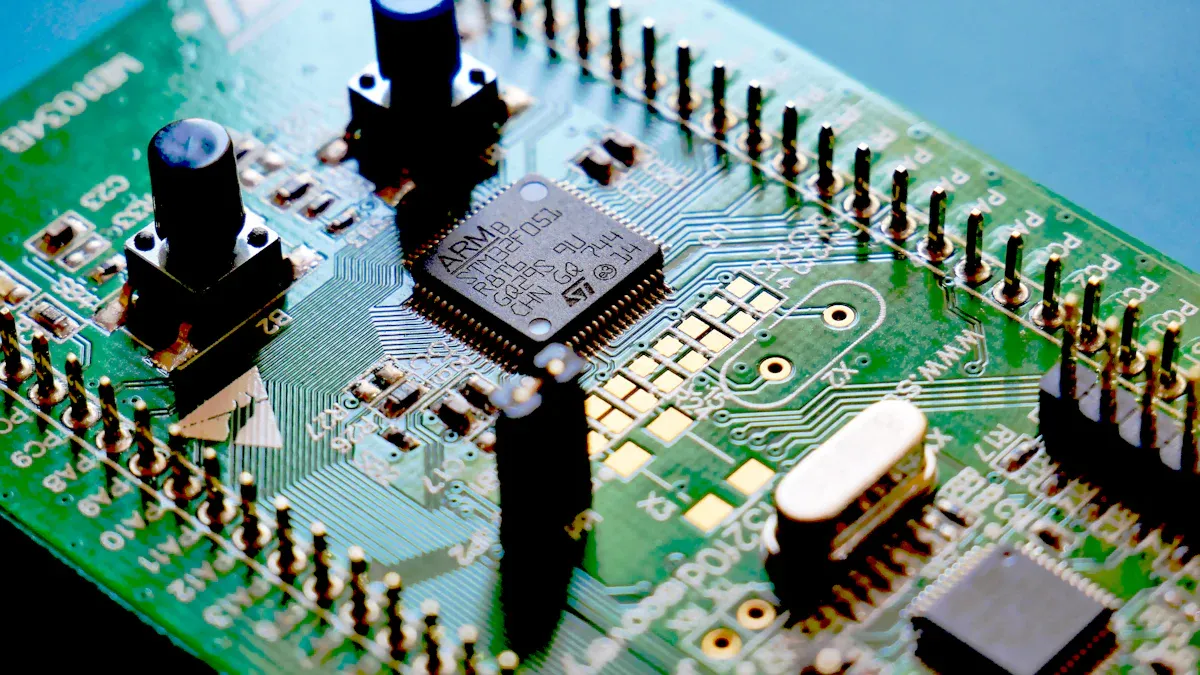In today’s electronics, flexibility is key. A flex LED PCB enables the creation of compact, adaptable designs that fit into tight spaces. Its lightweight nature and bendable properties make it ideal for applications like wearables, automotive lighting, and cutting-edge technology.
To excel in PCB design, having a solid plan is essential. Prioritize selecting the right materials, crafting an efficient layout, and ensuring durability. Start designing smarter and more innovative solutions with flex LED PCBs today!
Key Takeaways
- Flexible LED PCBs are light and bendable, perfect for small designs in wearables and car lights.
- Picking good materials, like polyimide, helps with bending and heat resistance, making your PCB last longer.
- A good power and grounding setup keeps current steady, stops overheating, and boosts performance.
- Use smooth curves and keep parts away from bending spots to avoid stress and make it last longer.
- Testing and using simulation tools find problems early, saving time and making the product better.
Basics of Flexible PCBs

What Makes a Flex LED PCB Unique?
Flex LED PCBs are special because they can bend and twist. They fit into small spaces and curved surfaces easily. Unlike stiff PCBs, these flexible ones help create cool, new designs. This makes them useful where regular PCBs won’t work.
Flex PCBs are very light, which is great for portable gadgets. They make products lighter but still work really well. They are also strong and can handle bending many times. This mix of being bendable and tough makes them important in today’s electronics.
Another cool thing is how they work in wearable tech. For example, they’re perfect for smartwatches and fitness bands. Flex PCBs let you design comfy and stylish gadgets. With them, you can create without being stuck with stiff designs.
Key Applications of Flexible PCBs
Flexible PCBs have changed how things are made in many industries. In cars, they help make smooth, curved lights that look great. They fit into tight spots, so car makers love using them.
In gadgets, flex PCBs are in foldable phones and tablets. These devices need PCBs that bend but don’t break. Flex PCBs help make exciting products that people enjoy using.
Wearable tech also uses flex PCBs a lot. From fitness bands to health devices, they are light and bendy. They let you make gadgets that fit the body and feel good to wear.
In factories, flex PCBs are used in machines and tools. They help save space and make things work better. By using their special features, you can build modern solutions for industries.
Choosing the Right Materials
Picking the Best Base for Flexibility
Choosing the right base material is very important. It helps your flexible PCB bend without breaking and keeps it working well. Polyimide is a popular choice because it bends easily, handles heat, and lasts a long time. This makes it great for things like wearable gadgets and car lights.
Polyester is another option. It’s cheaper and lighter but not as strong. It works for simple designs that don’t need to last forever. For harder designs, flex-rigid PCBs are a good choice. They mix bendable and stiff layers for flexibility and support.
Think about where your PCB will be used. Heat, water, or pressure can affect how it works. Picking the right material makes sure your PCB stays strong and works well.
Why Good Glue and Conductive Materials Matter
Glue and conductive materials are super important for flexible PCBs. Good glue keeps the layers stuck together, even when bending. Conductive materials, like copper, make sure electricity flows while staying flexible.
One example is thermal conductive silica gel (S-TCSG). It helps get rid of heat and keeps parts stable. It also cushions parts and handles stress well. Studies show that using the right amount of S-TCSG makes PCBs work better.
| Feature | Details |
|---|---|
| Material | Thermal conductive silica gel (S-TCSG) |
| Importance | Helps with heat control and keeps parts stable |
| Mechanical Benefits | Cushions parts and handles stress |
| Study Focus | Looked at how stress and strain affect performance |
| Real-World Use | Helps find the best coating thickness for better PCB results |
Using high-quality glue and conductive materials makes your PCB last longer and work better. This is extra important for flex-rigid PCBs, which need to be both bendable and strong.
Designing for Efficiency
Power Supply and Grounding Line Layout
A good power and grounding layout is very important. For a flex LED PCB, it’s even more critical. Power must flow smoothly without interruptions or drops. Create a special power plane to spread current evenly. This also helps prevent overheating.
Grounding is just as important. A strong grounding line reduces electrical noise and keeps performance stable. Use one continuous ground plane if you can. This lowers interference and makes your flexible circuit more reliable.
- Tip: Keep power and ground lines short and direct. This lowers resistance and boosts efficiency.
For flex-rigid PCBs, focus on the areas where flexible and rigid parts meet. These spots can get stressed and damage power or ground lines. Add extra layers or protective materials to keep them strong.
Optimizing Component Placement and Trace Routing
Placing components and routing traces well is key for success. Group related parts together to shorten traces and reduce signal loss. Put important parts, like LEDs and drivers, in spots with little bending. This avoids damage and keeps them working well.
When routing traces, keep it simple. Don’t use sharp angles or tight bends, as they can weaken the board. Use smooth curves to protect the traces. Keep signal traces away from power lines to avoid interference.
- Note: Use a grid-based tool to plan where parts go. This helps you place them precisely and avoid overlapping traces.
For flex-rigid PCBs, think about the flexible and rigid sections. Place heavier parts on the rigid areas to avoid stressing the flexible ones. Use staggered vias to connect layers. This makes the board stronger and less likely to break.
By planning your layout and routing carefully, you can make a flexible PCB that works well and lasts long. This step is vital for meeting today’s electronic needs.
Enhancing Durability
Avoiding Stress Points in Flexible PCB Designs
Stress points can weaken your flexible PCB and cause damage. These areas face extra strain, leading to cracks or breaks. To prevent this, spread out the stress in your design.
First, avoid sharp bends in your PCB. Sharp angles can easily break when bent often. Use smooth curves instead to lower the strain. For spots that bend a lot, add protective layers or use flex-rigid PCBs. These combine flexible and stiff parts for strength and flexibility.
Second, don’t place parts or vias near bending areas. Parts in these spots can loosen or stop working due to stress. Keep important components in stiff sections or areas with little movement. This simple change can make your PCB last longer.
Lastly, think about where your PCB will be used. Heat, moisture, or shaking can increase stress. Pick materials and coatings that can handle these conditions. By fixing stress points early, your PCB will work better for a longer time.
- Tip: Use simulation software to find stress points before making your PCB. This saves time and money.
Understanding Material Mechanical Properties
The materials you choose affect how strong your flex LED PCB is. Picking the right ones helps it handle bending and tough conditions without breaking.
Start by checking how flexible your base material is. Polyimide is a top choice because it bends well and resists heat. If your design needs both stiff and flexible parts, flex-rigid PCBs are a smarter option. They support stiff parts while staying bendable where needed.
Next, look at the material’s tensile strength. High tensile strength means it can stretch without tearing. This is crucial for flexible PCBs in wearables or car lights.
Finally, focus on adhesives and conductive materials. Good adhesives stop layers from peeling, even under stress. Conductive materials like copper should bend easily but still carry electricity well. Balancing these features keeps your PCB strong and working properly.
- Note: Test your materials in real-world settings. Lab tests might not show how they perform in actual use, so field testing is key.
Managing Electrical and Thermal Performance

Keeping Current Flow Stable
Stable current flow is very important for flexible PCBs. If the current is uneven, parts can overheat or fail. To stop this, design a system that keeps current smooth and steady.
Make a special power plane to spread current evenly. This lowers resistance and avoids hot spots. Use wide lines for power to handle more current safely. For grounding, a single ground plane works best. It reduces noise and keeps performance stable.
Controlled impedance routing is also important. It keeps signals clear, especially in fast circuits. Place parts carefully to avoid interference. This makes your PCB work better overall.
- Tip: Test your current flow with simulation tools before building. This helps find and fix problems early.
Managing Heat Effectively
Heat control is as important as current flow. Without it, your PCB might overheat and stop working. Use smart ways to keep your PCB cool and safe.
Thermal vias help move heat away from key parts. These tiny holes spread heat across the board. High-Tg materials are also great. They handle high heat and work well in tough conditions.
Heat sinks are another good option. They pull heat away and keep the PCB cool. For flex-rigid PCBs, put heat-sensitive parts in stiff areas. This stops bending from affecting heat control.
Here’s a quick look at electrical and heat management tips:
| Aspect | Description |
|---|---|
| Thermal Management | Use thermal vias, heat sinks, and high-Tg materials to control heat and keep the PCB stable. |
| Signal Integrity | Controlled routing and smart part placement keep signals clear and accurate. |
| Component Layout | Good part placement reduces interference and improves PCB performance. |
By using these tips, your flexible PCB will work well in different situations.
Prototyping and Testing
Making and Testing Early Models
Building early models is very important in flexible circuit design. It helps find problems before making the final product. Start with a minimum viable product (MVP). This lets you test basic features and get feedback. Early users can share ideas to improve your design. This saves both time and money.
Another helpful method is paper modeling. Use simple materials to draw your design. This makes sharing ideas easy and allows quick changes. Watching how people use these models shows design problems. Fixing these issues early makes the process smoother.
| Method | What It Does | Why It Helps |
|---|---|---|
| MVP Testing | Gets feedback on basic product features. | Helps create better products while saving time and money. |
| Paper Modeling | Uses simple materials to sketch designs. | Makes sharing ideas easy and allows fast changes based on feedback. |
| User Testing | Watches real users interact with models to find problems. | Shows areas to improve before spending too much on the design. |
Testing early models helps confirm your design works well. This step is key to making a strong and useful product.
Using Simulation Tools to Check Designs
Simulation tools are great for testing flexible circuit designs. They let you check your PCB in a virtual space, avoiding costly mistakes. Use them to study current flow, heat control, and bending stress. This ensures your design meets all needs before production.
For example, you can test how your PCB handles bending and twisting. This shows weak spots and helps make it stronger. Simulations also predict how heat spreads across the board. Fixing these issues early improves your design’s performance.
- Tip: Compare simulation results with real-world tests. This gives the best understanding of how your design will work.
Adding simulation tools to your process saves time and builds trust in your product. It’s a smart way to make sure your flexible PCB works well in real life.
Manufacturing and Assembly
Working with Skilled Flexible PCB Makers
Picking the right PCB maker is very important. A good manufacturer makes sure your design is accurate and reliable. Skilled makers use advanced tools and knowledge to improve your product. They also help you avoid expensive mistakes during production.
For instance, companies like PCBasic are known for their great quality and speed. They test every PCB carefully to meet high standards. Customers often praise their smooth service, quick delivery, and helpful support.
| Customer Reviews | Highlights |
|---|---|
| "We’ve worked with PCBasic for years..." | Very happy with quality, speed, and delivery. |
| "PCBasic’s quality is amazing..." | Careful testing ensures reliable products. |
| "Working with PCBasic has been easy..." | Great technical help and high-quality results. |
| "Fast delivery and top-notch quality..." | Positive experience with ordering and production. |
Teaming up with a trusted maker improves your PCB quality. It also makes production easier and more successful. This teamwork is key to great PCB projects.
Explaining Design Needs Clearly
Clear instructions are key to making good PCBs. Writing down your design needs well avoids mistakes. This helps the maker understand exactly what you want.
To make communication better, follow these tips:
- Explain all system parts and how they connect.
- Choose managers to handle agreements and solve problems.
- Define the project clearly so everyone knows the goals.
These steps help your team and the maker work together smoothly. This saves time and ensures your PCB turns out as planned.
Careful Handling and Assembly of Flex LED PCBs
Flex LED PCBs need gentle handling. Rough treatment can damage them or shorten their life. Always use the right tools and methods to keep your design safe.
When assembling, don’t bend or twist the PCB too much. Use holders to keep it steady and avoid stress. Solder at the right heat to protect the flexible materials. For flex-rigid PCBs, handle the stiff parts gently to avoid harming the flexible areas.
Careful handling helps your PCB last longer and work well. By focusing on proper assembly, you protect your work and deliver a great product.
Making flexible LED PCBs needs careful planning and smart choices. Pick the right materials, design good layouts, and test models to build strong and efficient boards. Every step helps improve how well they work.
- Pro Tip: Begin with simple designs, test frequently, and adjust based on real-world use. This saves time and makes your designs better.
For tough projects, ask experts for help. Their advice can solve problems and lead to great results. Start now and turn your creative ideas into reality!










 2025-05-05
2025-05-05
 BEST
BEST

.png)
.png)
.png)
.png)

.png)

